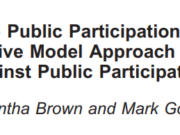In this article, Jay Goodliffe presents a “repeated election model of campaign fund-raising and spending,” in which incumbents are allowed to form war chests with saved money from previous elections. Goodliffe explores when war chests are most important and what type of incumbent finds it prudent to create them. He finds that strong incumbents are the least likely to find it necessary to create a large war chest while medium-strength incumbents most often attempt to build a sizeable war chest. After his analysis, Goodliffe determines that it is not weak incumbents who build large war chests, but rather it is medium-strength incumbents, who are at least likely to defeat a challenger in a given election. This is an important departure from conventional wisdom regarding war chests and an interesting take on campaign finance savings.
For further reading on this issue in other studies by Jay Goodliffe, see:
- “Campaign Fund-raising and Spending for Deterrence and Savings” (2009)
- “Campaign War Chests and Challenger Quality in Senate Elections” (2007)
- “War Chests as Precautionary Savings” (2004)
- “The Effect of War Chests on Challenger Entry in U.S. House Elections” (2001)
- “Campaign Finance in U.S. House Primary and General Elections” (2001)














